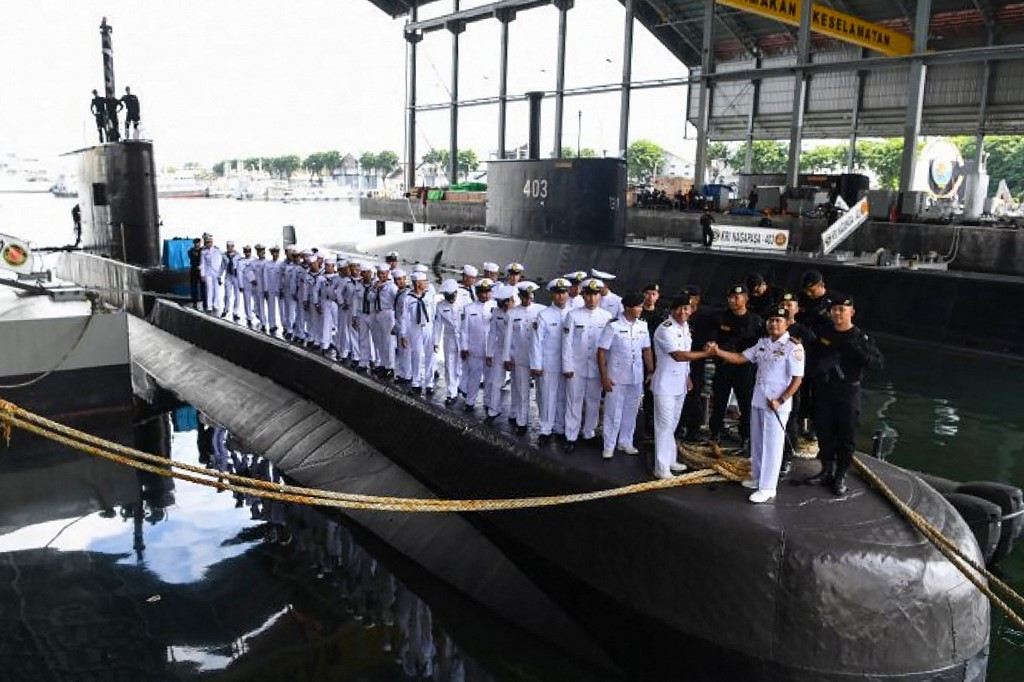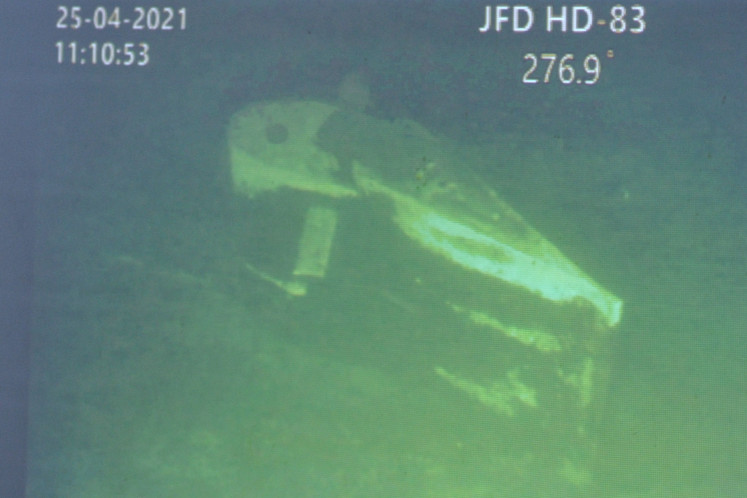Popular Reads
Top Results
Can't find what you're looking for?
View all search resultsPopular Reads
Top Results
Can't find what you're looking for?
View all search resultsAll hands on deck to salvage sunken Nanggala submarine
Three Chinese navy ships have joined the operation to lift the KRI Nanggala-402 submarine from the bottom of the Bali Sea, but a particular type of underwater currents complicates the mission.
Change text size
Gift Premium Articles
to Anyone
I
ndonesia and the world grieved in late April when the Indonesian Navy officially announced that KRI Nanggala-402 submarine had “sunk” with 53 sailors on board, days after having lost contact during a training exercise.
During a live torpedo training exercise on April 21, the submarine lost contact shortly after the crew had asked for permission to dive. A search team later spotted an oil spill where the vessel is thought to have submerged, raising concerns about an accident.
The Nanggala-402 submarine, which entered service in 1977, was found four days later at a depth of 838 meters below sea level -- far exceeding its maximum operating depth at around 500 m. The vessel was found around 1.3 kilometers south of its last known location.
The submarine had broken into three parts, with portions of its stern and bow detached from its hull. They also detected cracks on its hull.
Read also: Families remember victims of Nanggala disaster
Previously, the rescuers found several items presumably stemming from the vessel, including an escape vest that suggested an emergency situation had required the crew to put the vests on.
Various Indonesian and foreign entities are now joining hands to bring the remains of the submarine and its crews to the surface, but the operation will not be a walk in the park, as technical and natural challenges need to be overcome.
Help from Chinese navy
Navy chief of staff planning and budget assistant Rear Adm. Muhammad Ali recently said the salvage operation was likely to be difficult and require specific equipment.
“We’d need to attach hooks to the submarine using either a robot or divers equipped with special suits that can withstand the pressure of such depths,” Ali said in a press briefing on Thursday.
While the salvage team had succeeded in lifting small parts of the submarine, he added it still faced a challenge in lifting the larger parts.
The operation received a boost after three Chinese Navy salvage ships recently joined the mission. The ships were sent after China’s ambassador to Indonesia had offered his country’s assistance in recovering the submarine, which was promptly accepted by Indonesia, AFP reported.
Read also: Chinese Navy to help salvage sunken KRI Nanggala 402 submarine
Indonesian Navy spokesperson Cdre. Julius Wdjojono confirmed on Saturday that the Chinese vessels had joined the operation after entering Indonesian waters in late April, as reported by kompas.com.
Two of the Chinese vessels, the Tan Suo-2 and Nantuo-195, have capabilities for salvaging underwater objects. Meanwhile, the other ship, Yongxungdao-863, is equipped with a deep-submergence rescue vehicle (DSRV) usually used for the rescue of submarines as well as a sonar scanner.
The Chinese navy ships arrived after other foreign ships from Australia, Singapore and Malaysia left the archipelago. They had assisted Indonesian authorities in finding the submarine.
Ali added that a ship from the Upstream Oil and Gas Regulatory Special Task Force (SKK Migas) had also joined the mission. The ship is primarily used for drilling operations and has a crane with a capacity of 1,200 metric tons.
The Indonesian Navy previously considered using high-powered magnets and air balloons as a possible method for hauling up the submarine from the seabed. But officers had yet to decide on which approach to use for salvaging the Nanggala-402.
Internal waves
Apart from the technical challenges, Ali said the natural conditions in the Bali Sea hindered the team from immediately bringing the submarine to the surface.
He was referring to an underwater current phenomenon known as internal waves. According to the European Space Agency, it usually occurs when “the water body consists of layers of different density [...] due to difference in water temperature [or] salinity.” Natural objects, such as a rocky ocean floor and sills, could also help generate such waves when strong currents passed through them.
The wave is known to be able to generate a vertical current and quickly sink objects to deep waters.
Ali previously cited the internal waves as a possible cause behind the sinking of the Nanggala-402, but he quickly added that the investigation to determine the exact cause was ongoing, as reported by kompas.com.
Read also: Video of KRI Nanggala 402 crew singing goodbye song went viral
Researcher Adi Purwandana of the Indonesian Institute of Sciences' (LIPI) Research Center for Oceanography said the internal waves might hinder the salvage operation, as they appeared every 12 hours, following the tidal flows.
He added that the waves tended to get higher below the surface. Extreme heights of between 150 m and 200 m could be reached during spring tide, which occurs every two weeks.
Internal waves are commonly observed in the Bali Sea because of a disruption to underwater tides flowing from the Indian Ocean to the deep part of Indonesian seas through the Lombok Strait by a natural sill near Nusa Penida Island.
“It’s better for [the salvage team] to avoid it, particularly during the spring tide period,” Adi told The Jakarta Post on Saturday.
‘Time for evaluation’
Indonesian Military (TNI) commander Air Chief Marshal Hadi Tjahjanto said the incident served as a trigger to thoroughly audit the condition of the country’s current weaponry systems and procurement plans.
“This is the right time to evaluate the military’s primary weaponry systems, especially the Navy’s submarines. We’re also looking into our future decisions to modernize the vessels,” Hadi said on Thursday during a hearing with House of Representatives Commission I, which oversees defense.
He called the incident “a valuable lesson” to recognize the high-risk nature of the soldiers’ duty, including facing harsh environmental conditions.
Read also: President Jokowi sends condolences to families of sunken submarine crew
Paramadina University lecturer Anton Aliabbas said the government should review all orders to purchase military equipment, particularly from foreign producers.
“What should be prioritized going forward is to buy battle-proven equipment with a reputable track record to prevent [similar incidents],” he said.
Anton also urged the government to be transparent to the public over its plants to procure military equipment, rather than hiding them on the grounds of protecting state secrets. This way, the public could monitor whether the government had purchased the best equipment possible, he went on to say.











